Court Process and Duties: Ethics, Conflicts, and Judges
VerifiedAdded on 2020/05/01
|9
|1512
|242
Case Study
AI Summary
This case study delves into the intricacies of court processes and the corresponding duties of legal professionals. It examines the ethical considerations within the legal field, including the obligations of lawyers and the principles governing their conduct, such as the provision of free legal services and the handling of conflicts of interest. The assignment addresses the legality of solicitors acting for multiple parties, the principles of disqualification, and the duties of judges in the context of litigation. It explores the inherent jurisdiction of the High Court, the importance of maintaining justice and public confidence in the judicial system, and the concept of a contextual approach to judging. The study analyzes the balance between legal certainty and achieving just outcomes, emphasizing the importance of loyalty, confidentiality, and the duty to present all relevant legal information to the court. The case study provides a comprehensive overview of the legal and ethical landscape, offering insights into the responsibilities and challenges faced by legal practitioners and the judiciary.
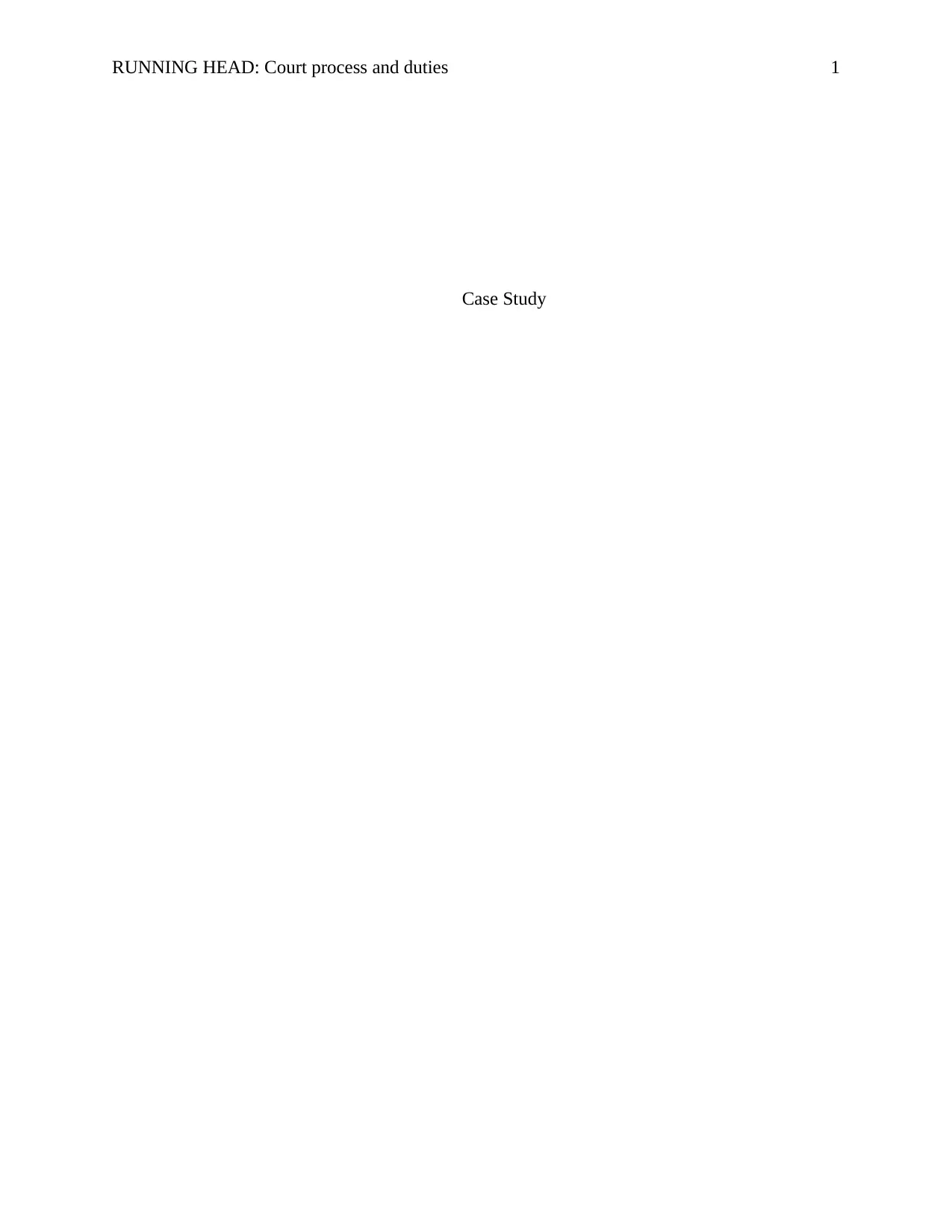
RUNNING HEAD: Court process and duties 1
Case Study
Case Study
Paraphrase This Document
Need a fresh take? Get an instant paraphrase of this document with our AI Paraphraser
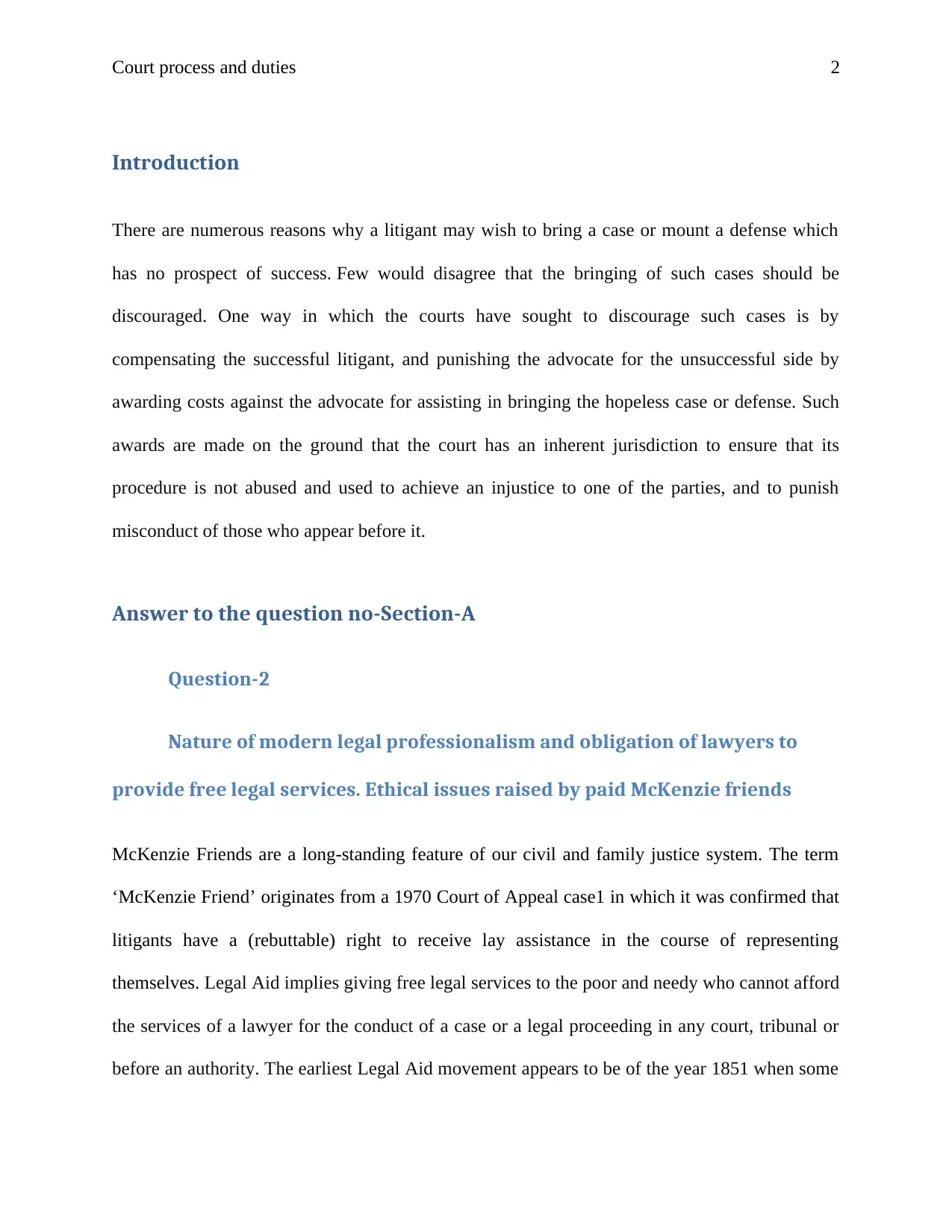
Court process and duties 2
Introduction
There are numerous reasons why a litigant may wish to bring a case or mount a defense which
has no prospect of success. Few would disagree that the bringing of such cases should be
discouraged. One way in which the courts have sought to discourage such cases is by
compensating the successful litigant, and punishing the advocate for the unsuccessful side by
awarding costs against the advocate for assisting in bringing the hopeless case or defense. Such
awards are made on the ground that the court has an inherent jurisdiction to ensure that its
procedure is not abused and used to achieve an injustice to one of the parties, and to punish
misconduct of those who appear before it.
Answer to the question no-Section-A
Question-2
Nature of modern legal professionalism and obligation of lawyers to
provide free legal services. Ethical issues raised by paid McKenzie friends
McKenzie Friends are a long-standing feature of our civil and family justice system. The term
‘McKenzie Friend’ originates from a 1970 Court of Appeal case1 in which it was confirmed that
litigants have a (rebuttable) right to receive lay assistance in the course of representing
themselves. Legal Aid implies giving free legal services to the poor and needy who cannot afford
the services of a lawyer for the conduct of a case or a legal proceeding in any court, tribunal or
before an authority. The earliest Legal Aid movement appears to be of the year 1851 when some
Introduction
There are numerous reasons why a litigant may wish to bring a case or mount a defense which
has no prospect of success. Few would disagree that the bringing of such cases should be
discouraged. One way in which the courts have sought to discourage such cases is by
compensating the successful litigant, and punishing the advocate for the unsuccessful side by
awarding costs against the advocate for assisting in bringing the hopeless case or defense. Such
awards are made on the ground that the court has an inherent jurisdiction to ensure that its
procedure is not abused and used to achieve an injustice to one of the parties, and to punish
misconduct of those who appear before it.
Answer to the question no-Section-A
Question-2
Nature of modern legal professionalism and obligation of lawyers to
provide free legal services. Ethical issues raised by paid McKenzie friends
McKenzie Friends are a long-standing feature of our civil and family justice system. The term
‘McKenzie Friend’ originates from a 1970 Court of Appeal case1 in which it was confirmed that
litigants have a (rebuttable) right to receive lay assistance in the course of representing
themselves. Legal Aid implies giving free legal services to the poor and needy who cannot afford
the services of a lawyer for the conduct of a case or a legal proceeding in any court, tribunal or
before an authority. The earliest Legal Aid movement appears to be of the year 1851 when some
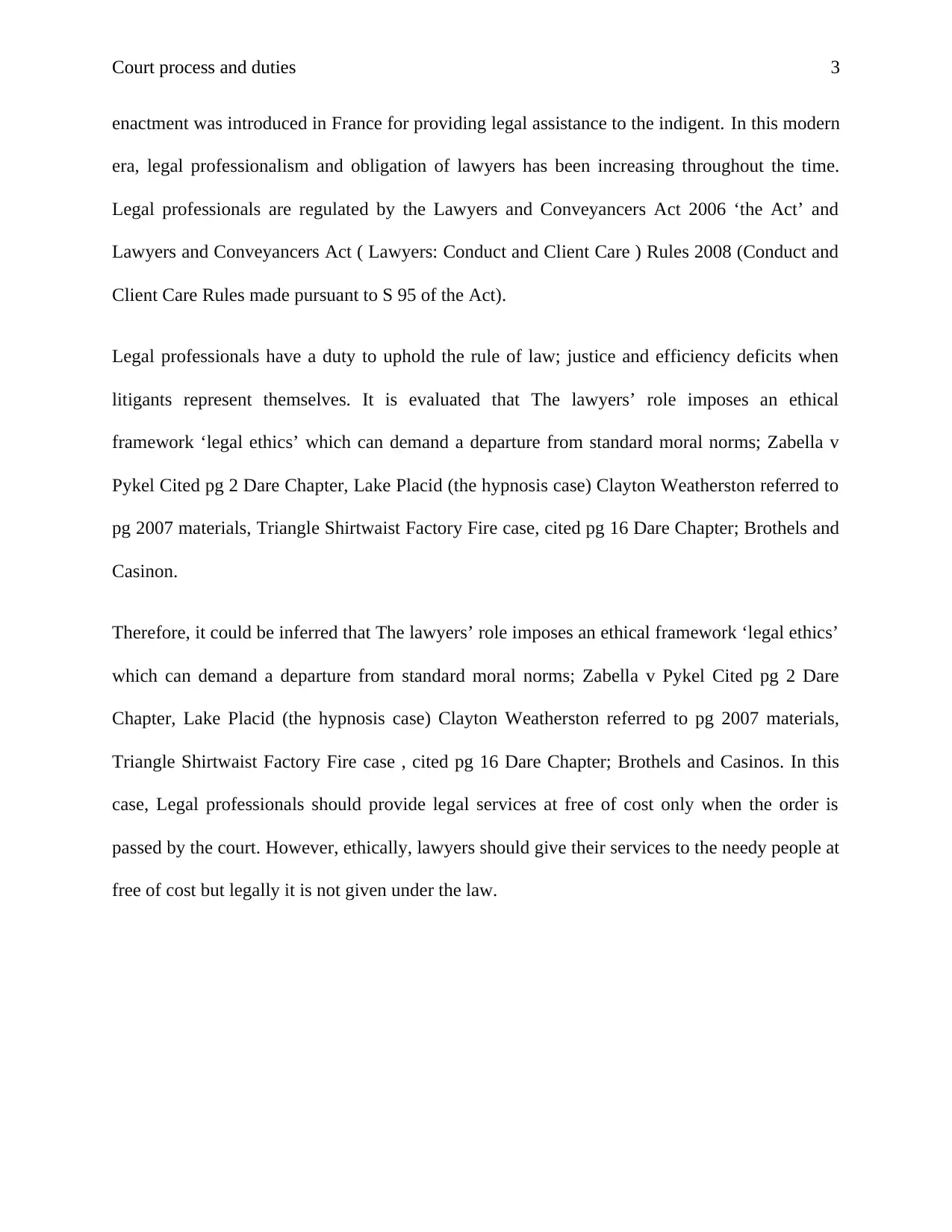
Court process and duties 3
enactment was introduced in France for providing legal assistance to the indigent. In this modern
era, legal professionalism and obligation of lawyers has been increasing throughout the time.
Legal professionals are regulated by the Lawyers and Conveyancers Act 2006 ‘the Act’ and
Lawyers and Conveyancers Act ( Lawyers: Conduct and Client Care ) Rules 2008 (Conduct and
Client Care Rules made pursuant to S 95 of the Act).
Legal professionals have a duty to uphold the rule of law; justice and efficiency deficits when
litigants represent themselves. It is evaluated that The lawyers’ role imposes an ethical
framework ‘legal ethics’ which can demand a departure from standard moral norms; Zabella v
Pykel Cited pg 2 Dare Chapter, Lake Placid (the hypnosis case) Clayton Weatherston referred to
pg 2007 materials, Triangle Shirtwaist Factory Fire case, cited pg 16 Dare Chapter; Brothels and
Casinon.
Therefore, it could be inferred that The lawyers’ role imposes an ethical framework ‘legal ethics’
which can demand a departure from standard moral norms; Zabella v Pykel Cited pg 2 Dare
Chapter, Lake Placid (the hypnosis case) Clayton Weatherston referred to pg 2007 materials,
Triangle Shirtwaist Factory Fire case , cited pg 16 Dare Chapter; Brothels and Casinos. In this
case, Legal professionals should provide legal services at free of cost only when the order is
passed by the court. However, ethically, lawyers should give their services to the needy people at
free of cost but legally it is not given under the law.
enactment was introduced in France for providing legal assistance to the indigent. In this modern
era, legal professionalism and obligation of lawyers has been increasing throughout the time.
Legal professionals are regulated by the Lawyers and Conveyancers Act 2006 ‘the Act’ and
Lawyers and Conveyancers Act ( Lawyers: Conduct and Client Care ) Rules 2008 (Conduct and
Client Care Rules made pursuant to S 95 of the Act).
Legal professionals have a duty to uphold the rule of law; justice and efficiency deficits when
litigants represent themselves. It is evaluated that The lawyers’ role imposes an ethical
framework ‘legal ethics’ which can demand a departure from standard moral norms; Zabella v
Pykel Cited pg 2 Dare Chapter, Lake Placid (the hypnosis case) Clayton Weatherston referred to
pg 2007 materials, Triangle Shirtwaist Factory Fire case, cited pg 16 Dare Chapter; Brothels and
Casinon.
Therefore, it could be inferred that The lawyers’ role imposes an ethical framework ‘legal ethics’
which can demand a departure from standard moral norms; Zabella v Pykel Cited pg 2 Dare
Chapter, Lake Placid (the hypnosis case) Clayton Weatherston referred to pg 2007 materials,
Triangle Shirtwaist Factory Fire case , cited pg 16 Dare Chapter; Brothels and Casinos. In this
case, Legal professionals should provide legal services at free of cost only when the order is
passed by the court. However, ethically, lawyers should give their services to the needy people at
free of cost but legally it is not given under the law.
⊘ This is a preview!⊘
Do you want full access?
Subscribe today to unlock all pages.

Trusted by 1+ million students worldwide
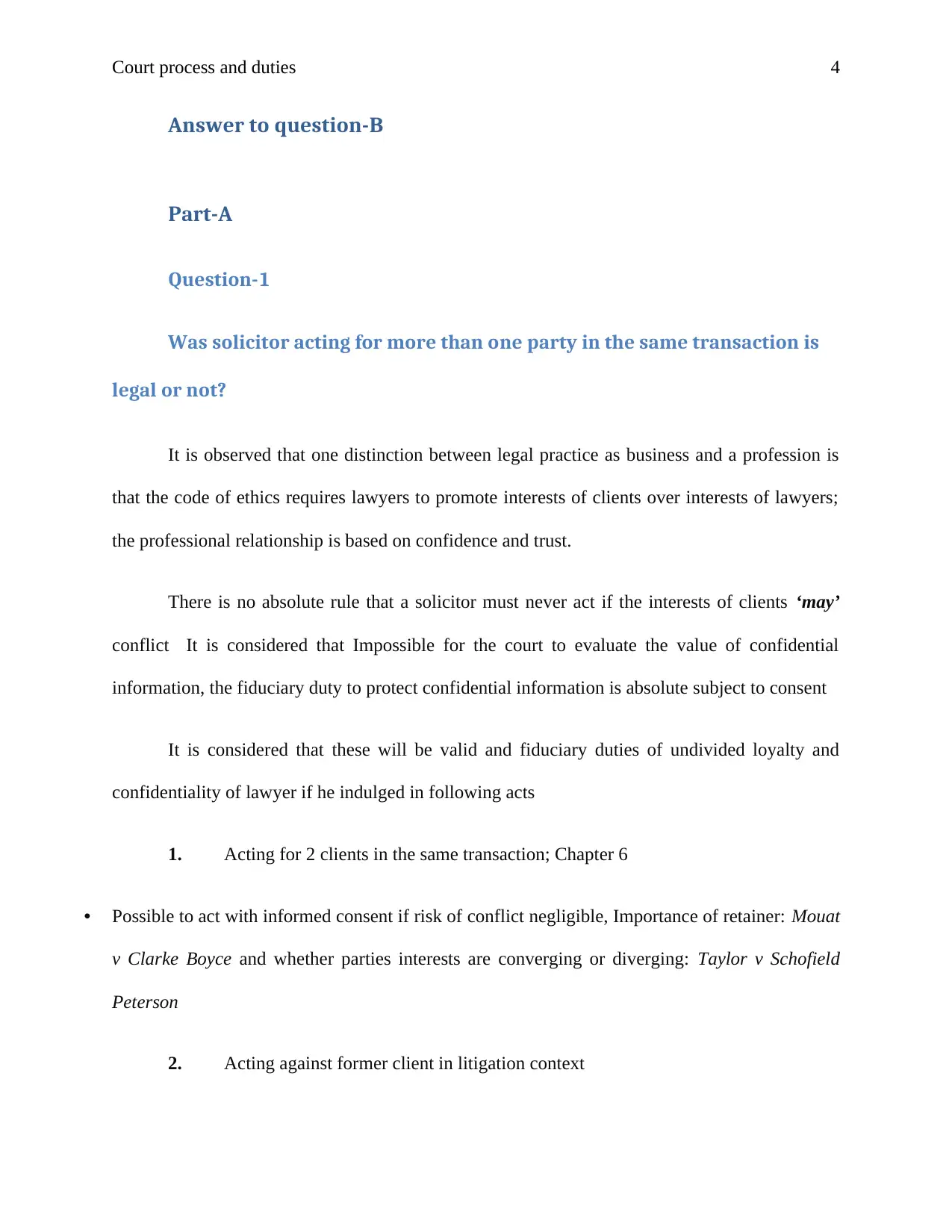
Court process and duties 4
Answer to question-B
Part-A
Question-1
Was solicitor acting for more than one party in the same transaction is
legal or not?
It is observed that one distinction between legal practice as business and a profession is
that the code of ethics requires lawyers to promote interests of clients over interests of lawyers;
the professional relationship is based on confidence and trust.
There is no absolute rule that a solicitor must never act if the interests of clients ‘may’
conflict It is considered that Impossible for the court to evaluate the value of confidential
information, the fiduciary duty to protect confidential information is absolute subject to consent
It is considered that these will be valid and fiduciary duties of undivided loyalty and
confidentiality of lawyer if he indulged in following acts
1. Acting for 2 clients in the same transaction; Chapter 6
• Possible to act with informed consent if risk of conflict negligible, Importance of retainer: Mouat
v Clarke Boyce and whether parties interests are converging or diverging: Taylor v Schofield
Peterson
2. Acting against former client in litigation context
Answer to question-B
Part-A
Question-1
Was solicitor acting for more than one party in the same transaction is
legal or not?
It is observed that one distinction between legal practice as business and a profession is
that the code of ethics requires lawyers to promote interests of clients over interests of lawyers;
the professional relationship is based on confidence and trust.
There is no absolute rule that a solicitor must never act if the interests of clients ‘may’
conflict It is considered that Impossible for the court to evaluate the value of confidential
information, the fiduciary duty to protect confidential information is absolute subject to consent
It is considered that these will be valid and fiduciary duties of undivided loyalty and
confidentiality of lawyer if he indulged in following acts
1. Acting for 2 clients in the same transaction; Chapter 6
• Possible to act with informed consent if risk of conflict negligible, Importance of retainer: Mouat
v Clarke Boyce and whether parties interests are converging or diverging: Taylor v Schofield
Peterson
2. Acting against former client in litigation context
Paraphrase This Document
Need a fresh take? Get an instant paraphrase of this document with our AI Paraphraser
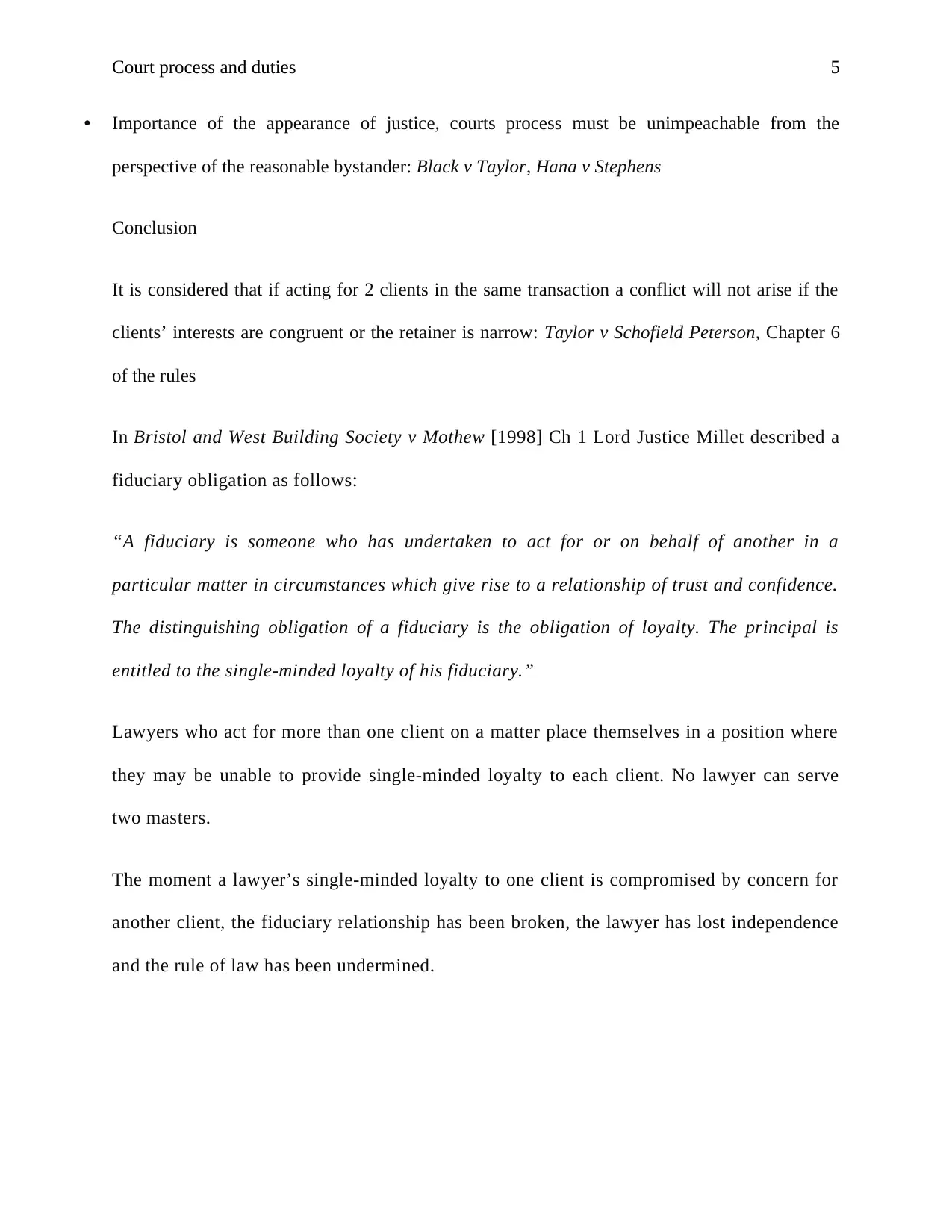
Court process and duties 5
• Importance of the appearance of justice, courts process must be unimpeachable from the
perspective of the reasonable bystander: Black v Taylor, Hana v Stephens
Conclusion
It is considered that if acting for 2 clients in the same transaction a conflict will not arise if the
clients’ interests are congruent or the retainer is narrow: Taylor v Schofield Peterson, Chapter 6
of the rules
In Bristol and West Building Society v Mothew [1998] Ch 1 Lord Justice Millet described a
fiduciary obligation as follows:
“A fiduciary is someone who has undertaken to act for or on behalf of another in a
particular matter in circumstances which give rise to a relationship of trust and confidence.
The distinguishing obligation of a fiduciary is the obligation of loyalty. The principal is
entitled to the single-minded loyalty of his fiduciary.”
Lawyers who act for more than one client on a matter place themselves in a position where
they may be unable to provide single-minded loyalty to each client. No lawyer can serve
two masters.
The moment a lawyer’s single-minded loyalty to one client is compromised by concern for
another client, the fiduciary relationship has been broken, the lawyer has lost independence
and the rule of law has been undermined.
• Importance of the appearance of justice, courts process must be unimpeachable from the
perspective of the reasonable bystander: Black v Taylor, Hana v Stephens
Conclusion
It is considered that if acting for 2 clients in the same transaction a conflict will not arise if the
clients’ interests are congruent or the retainer is narrow: Taylor v Schofield Peterson, Chapter 6
of the rules
In Bristol and West Building Society v Mothew [1998] Ch 1 Lord Justice Millet described a
fiduciary obligation as follows:
“A fiduciary is someone who has undertaken to act for or on behalf of another in a
particular matter in circumstances which give rise to a relationship of trust and confidence.
The distinguishing obligation of a fiduciary is the obligation of loyalty. The principal is
entitled to the single-minded loyalty of his fiduciary.”
Lawyers who act for more than one client on a matter place themselves in a position where
they may be unable to provide single-minded loyalty to each client. No lawyer can serve
two masters.
The moment a lawyer’s single-minded loyalty to one client is compromised by concern for
another client, the fiduciary relationship has been broken, the lawyer has lost independence
and the rule of law has been undermined.

Court process and duties 6
Question-2
Principles which apply to disqualification
There are following principles which are given as below
It is observed that Code of Professional Conduct; Lawyers are regulated by the Lawyers and
Conveyances Act 2006 ‘the Act’ and Lawyers and Conveyances Act (Lawyers: Conduct and
Client Care) Rules 2008 (Conduct and Client Care Rules made pursuant to S 95 of the Act)
Lawyer must not communicate with witness during or between x-examination/re-
examination, except for good reason and with consent of judge or other side/s otherwise it
may result to disqualification of their professional capacity.
Reputation of the others- Professional representative should not be allowed to indulge in
alleging fraud, dishonesty, undue influence, duress or other reprehensible conduct, unless
the lawyer has taken appropriate steps to ensure that reasonable grounds for making the
allegation exist. Y v M.
Lawyer must protect the court process to increase the efficiency of court litigation.
Question-2
Principles which apply to disqualification
There are following principles which are given as below
It is observed that Code of Professional Conduct; Lawyers are regulated by the Lawyers and
Conveyances Act 2006 ‘the Act’ and Lawyers and Conveyances Act (Lawyers: Conduct and
Client Care) Rules 2008 (Conduct and Client Care Rules made pursuant to S 95 of the Act)
Lawyer must not communicate with witness during or between x-examination/re-
examination, except for good reason and with consent of judge or other side/s otherwise it
may result to disqualification of their professional capacity.
Reputation of the others- Professional representative should not be allowed to indulge in
alleging fraud, dishonesty, undue influence, duress or other reprehensible conduct, unless
the lawyer has taken appropriate steps to ensure that reasonable grounds for making the
allegation exist. Y v M.
Lawyer must protect the court process to increase the efficiency of court litigation.
⊘ This is a preview!⊘
Do you want full access?
Subscribe today to unlock all pages.

Trusted by 1+ million students worldwide
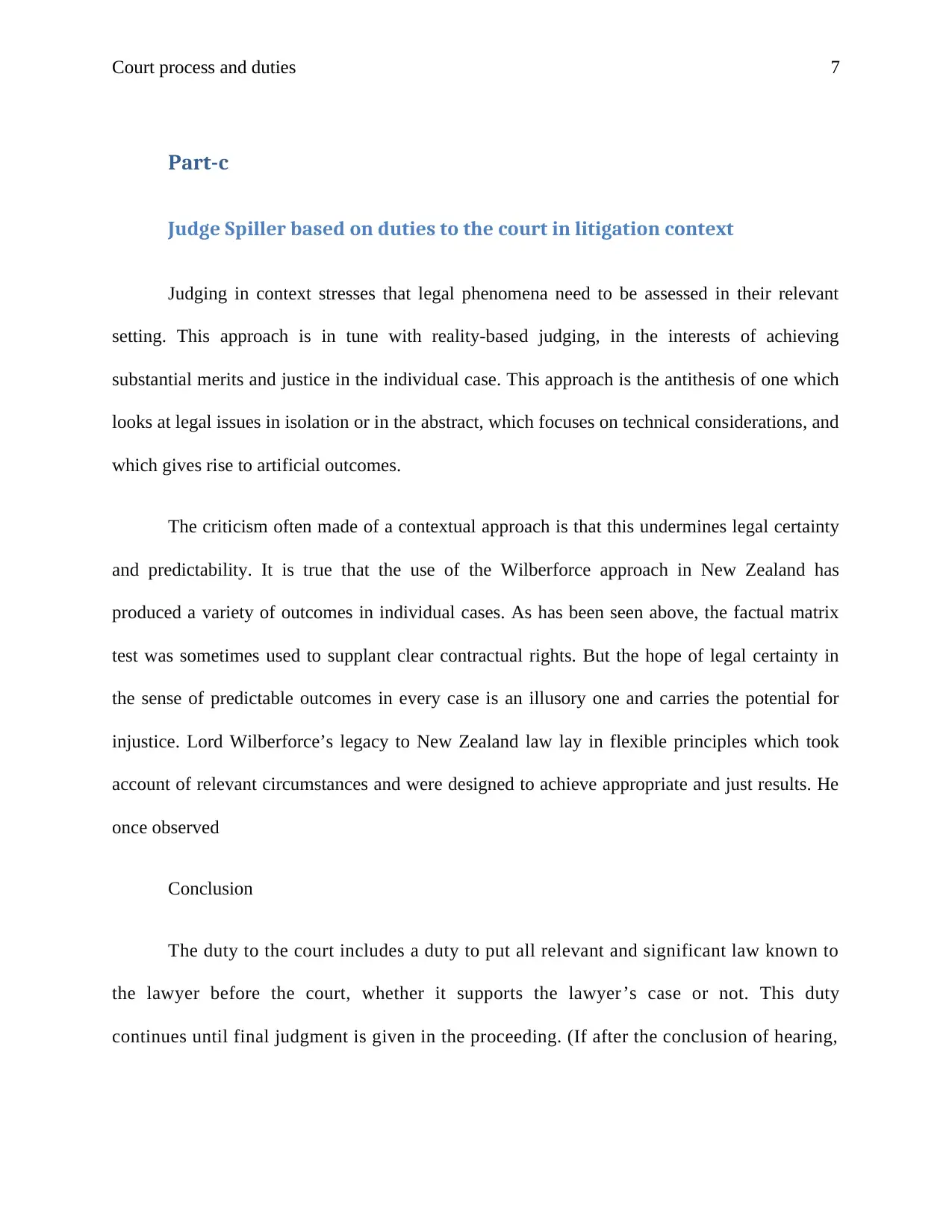
Court process and duties 7
Part-c
Judge Spiller based on duties to the court in litigation context
Judging in context stresses that legal phenomena need to be assessed in their relevant
setting. This approach is in tune with reality-based judging, in the interests of achieving
substantial merits and justice in the individual case. This approach is the antithesis of one which
looks at legal issues in isolation or in the abstract, which focuses on technical considerations, and
which gives rise to artificial outcomes.
The criticism often made of a contextual approach is that this undermines legal certainty
and predictability. It is true that the use of the Wilberforce approach in New Zealand has
produced a variety of outcomes in individual cases. As has been seen above, the factual matrix
test was sometimes used to supplant clear contractual rights. But the hope of legal certainty in
the sense of predictable outcomes in every case is an illusory one and carries the potential for
injustice. Lord Wilberforce’s legacy to New Zealand law lay in flexible principles which took
account of relevant circumstances and were designed to achieve appropriate and just results. He
once observed
Conclusion
The duty to the court includes a duty to put all relevant and significant law known to
the lawyer before the court, whether it supports the lawyer’s case or not. This duty
continues until final judgment is given in the proceeding. (If after the conclusion of hearing,
Part-c
Judge Spiller based on duties to the court in litigation context
Judging in context stresses that legal phenomena need to be assessed in their relevant
setting. This approach is in tune with reality-based judging, in the interests of achieving
substantial merits and justice in the individual case. This approach is the antithesis of one which
looks at legal issues in isolation or in the abstract, which focuses on technical considerations, and
which gives rise to artificial outcomes.
The criticism often made of a contextual approach is that this undermines legal certainty
and predictability. It is true that the use of the Wilberforce approach in New Zealand has
produced a variety of outcomes in individual cases. As has been seen above, the factual matrix
test was sometimes used to supplant clear contractual rights. But the hope of legal certainty in
the sense of predictable outcomes in every case is an illusory one and carries the potential for
injustice. Lord Wilberforce’s legacy to New Zealand law lay in flexible principles which took
account of relevant circumstances and were designed to achieve appropriate and just results. He
once observed
Conclusion
The duty to the court includes a duty to put all relevant and significant law known to
the lawyer before the court, whether it supports the lawyer’s case or not. This duty
continues until final judgment is given in the proceeding. (If after the conclusion of hearing,
Paraphrase This Document
Need a fresh take? Get an instant paraphrase of this document with our AI Paraphraser

Court process and duties 8
but before delivery of judgment, counsel wishes to make further submissions by counsel,
leave of the judge is required).
There are following procedure and justice which are given as below
• Inherent jurisdiction of High Court to control its own process which includes power to
determine who should be permitted to appear before it as an advocate
• Court exercise jurisdiction to ensure that justice is administered properly, to preserve public
confidence in the judicial system
• Justice not seen to be done if lawyer because of a previous connection with the opposite
party is in a conflict of interest position
• Justice not achieved if reasonable bystander would think it possible that conflict exited
but before delivery of judgment, counsel wishes to make further submissions by counsel,
leave of the judge is required).
There are following procedure and justice which are given as below
• Inherent jurisdiction of High Court to control its own process which includes power to
determine who should be permitted to appear before it as an advocate
• Court exercise jurisdiction to ensure that justice is administered properly, to preserve public
confidence in the judicial system
• Justice not seen to be done if lawyer because of a previous connection with the opposite
party is in a conflict of interest position
• Justice not achieved if reasonable bystander would think it possible that conflict exited

Court process and duties 9
⊘ This is a preview!⊘
Do you want full access?
Subscribe today to unlock all pages.

Trusted by 1+ million students worldwide
1 out of 9
Your All-in-One AI-Powered Toolkit for Academic Success.
+13062052269
info@desklib.com
Available 24*7 on WhatsApp / Email
![[object Object]](/_next/static/media/star-bottom.7253800d.svg)
Unlock your academic potential
Copyright © 2020–2025 A2Z Services. All Rights Reserved. Developed and managed by ZUCOL.